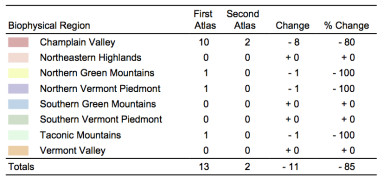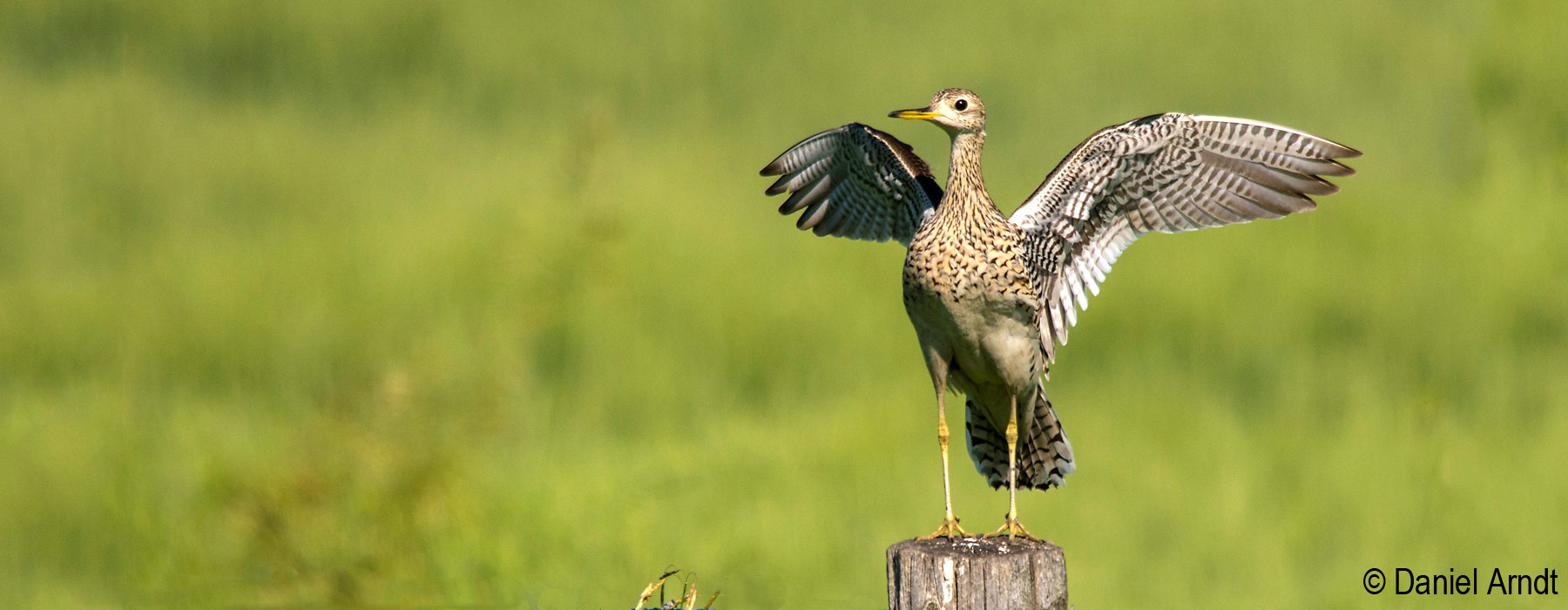Graceful and unusual, the Upland Sandpiper has been fondly described as a “pinhead.” Its moderate-sized body and long neck would seem to require a bird with a larger head. But that’s not this sandpiper’s only oddity. On its grassland breeding grounds, the Upland Sandpiper lets out a classic human “wolf-whistle” in flight.
Upland Sandpiper populations have greatly diminished in the Northeast. The Second Vermont Breeding Bird Atlas showed an 85% decline in the number of occupied blocks. They likely have been the victims of loss and fragmentation of grassland habitat as well as earlier and more frequent haying. They are now listed as Endangered in Vermont.
 Prior to 1989, no systematic survey had been conducted on the abundance of Upland Sandpiper in Vermont, although distribution of the species was documented during the first Vermont Breeding Bird Atlas Project. Concerns over the apparent decline of Upland Sandpipers in Vermont prompted dedicated surveys for this species in 1989-1992. Increases in adult numbers and the number of nesting sites during this period were documented; however, these increases were attributed to refinement of survey techniques as opposed to actual population increases. Highest counts during this period were 126 individuals located at 47 sites with a suspected stable population of 80-100 pairs. Another set of surveys was conducted in 1998 and 1999. The 1998 survey showed a 60% decline in numbers (50 individuals at 22 sites). The 1999 survey showed a decline of 78% with only 28 individuals at 15 sites. Subsequent, but more limited, surveys in 2000-2002 showed findings similar to 1999.
Prior to 1989, no systematic survey had been conducted on the abundance of Upland Sandpiper in Vermont, although distribution of the species was documented during the first Vermont Breeding Bird Atlas Project. Concerns over the apparent decline of Upland Sandpipers in Vermont prompted dedicated surveys for this species in 1989-1992. Increases in adult numbers and the number of nesting sites during this period were documented; however, these increases were attributed to refinement of survey techniques as opposed to actual population increases. Highest counts during this period were 126 individuals located at 47 sites with a suspected stable population of 80-100 pairs. Another set of surveys was conducted in 1998 and 1999. The 1998 survey showed a 60% decline in numbers (50 individuals at 22 sites). The 1999 survey showed a decline of 78% with only 28 individuals at 15 sites. Subsequent, but more limited, surveys in 2000-2002 showed findings similar to 1999.
Primary Survey Data Rescue in Progress
We are rescuing these primary survey data from paper reports, field data forms and paper maps that have been carefully filed in a cabinet for over 30 years. Upland Sandpiper breeding season roadside surveys, that were completed in 1989-1992 and again in 1998-1999, are being carefully examined and digitized to capture all survey site results (both present and absent) and the spatial locations. If possible, they will be converted to a format compatible with Vermont eBird and available there. Otherwise, they will be available as a Darwin Core file on GBIF through the Vermont Atlas of Life.
Reports
- Rimmer, Christopher, Christopher Fichtel (1989). A Breeding Season Status Survey of the Upland Sandpiper in Vermont. Unpub. report. (PDF)
- Peterson, Judith, Christopher Rimmer, Christopher Fichtel (1999). A Comparison of Two Population Monitoring Techniques for Upland Sandpipers in Vermont. Unpub. report (PDF)
- Peterson, Judith (1999). The Upland Sandpiper in Vermont, 1998-1999: A Declining Species. Unpub. report. (PDF)







